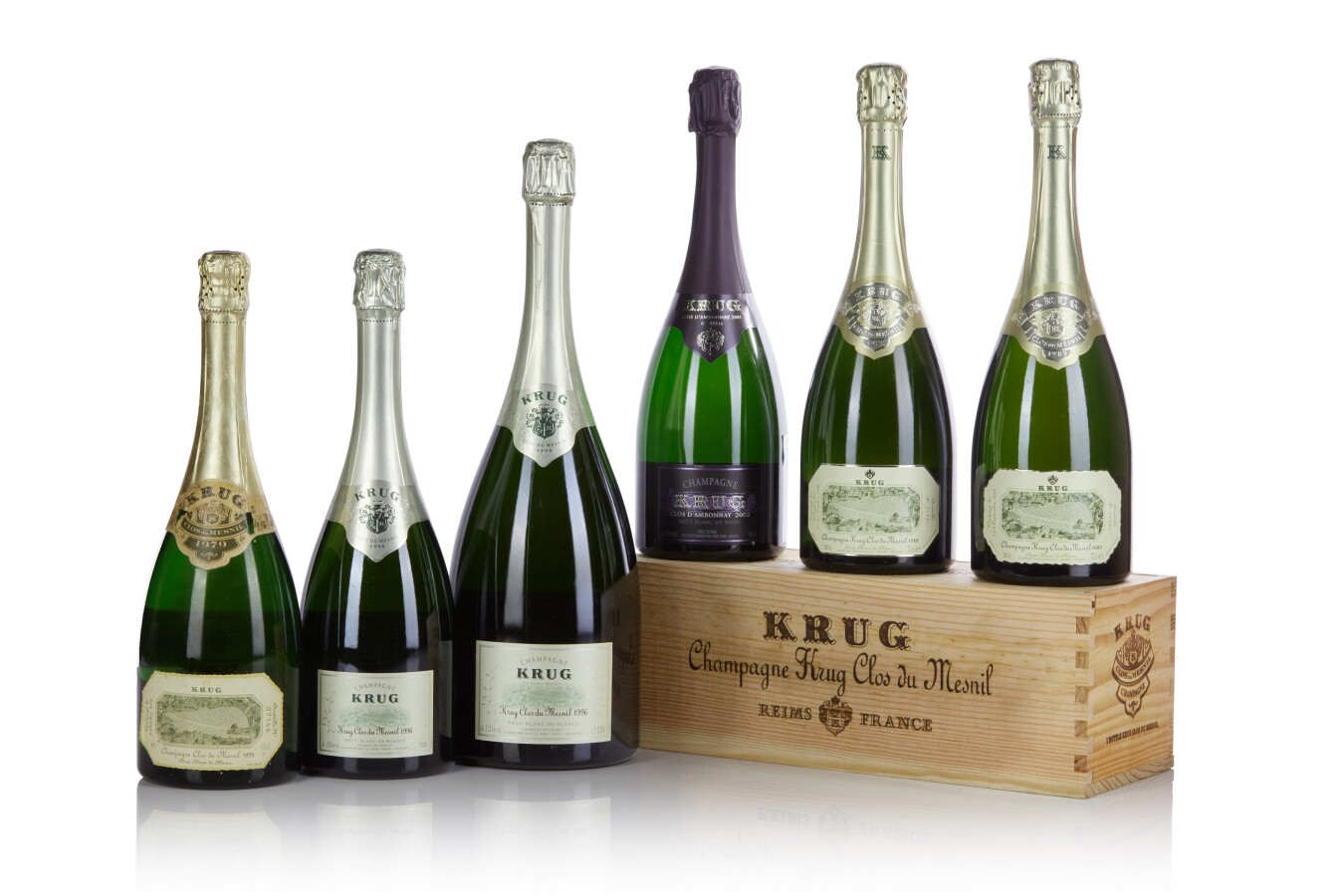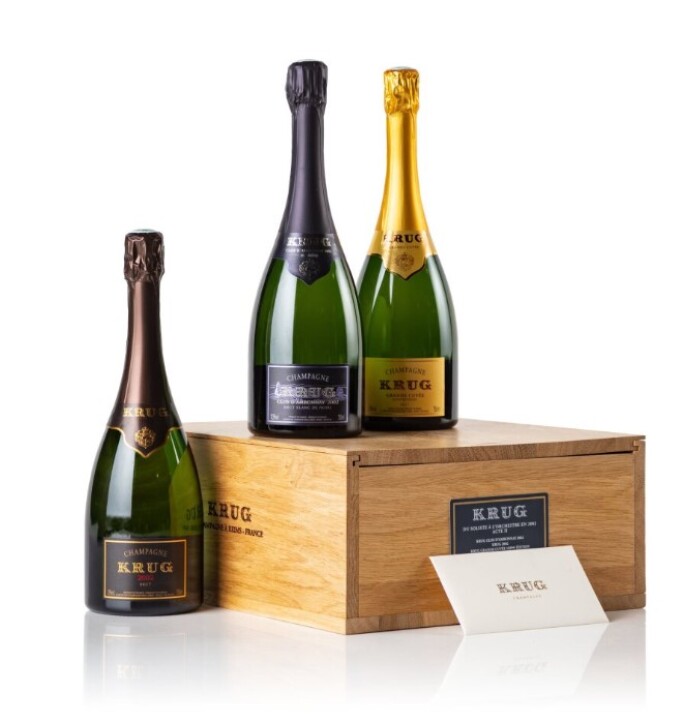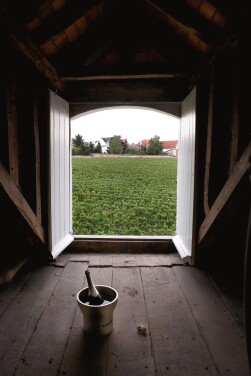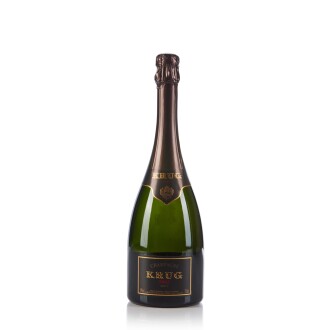F or many of us, there’s one wine we associate with the most special moments: Krug Champagne.
Sotheby’s serves Krug Grande Cuvée at many of our preauction dinners, and it’s the wine I most often recommend to clients looking for last-minute gifts. I’ve enjoyed it with long Sunday lunches or paired with both paella and cigars. I associate Krug Vintage Champagne with fine Burgundy dinners. In fact, it seems that most dinners accompanied by serious wine begin with Krug Champagne. And I think of Krug Collection as the perfect champagne for very special occasions. I had it once – a 1971 magnum for my friend’s 40th birthday, served to preface a lineup of red Burgundy from the same year. I’ve tried Clos du Mesnil Blanc de Blancs and Clos d’Ambonnay Blanc de Noirs on a few occasions, both as meal pairings that cemented the storied reputation of Krug Champagne. It is as much a wine lover’s champagne as it is one for enjoying with food.
A Brief History of Krug Champagne
In 1843, Joseph Krug established the House of Krug in Reims. He believed a great Champagne house should produce cuvées that are both nonvintage (a champagne blended to deliver the best expression year after year) and vintage (a champagne that reflects the conditions of each year). All cuvées should be equal, he argued – treated not as hierarchies, but as different expressions. These notions made him a visionary and have continued to inspire the house throughout the decades. Today, Krug Champagne is equally cherished by those who praise tradition and those who praise innovation.
Overview of Krug Champagne Production
Maison Krug owns 21 hectares, supplementing the rest with grapes from local growers, some of whom the family has worked with from the start. To promote aging, Maison Krug picks grapes with more acidity and less sugar. The wine is vinified in 205-liter oak barrels that are on average 20 years old. They do not stop malolactic fermentation if it occurs, but nor do they start it. After fermentation, the wine goes into tanks to promote freshness, and it’s then aged for at least seven years in the case of Grande Cuvée and more than ten years for the Vintage. The process results in a big, rich style that often shows acidity in its youth and benefits from age.
Krug Champagne and the First Ever Champagne-Only Auction (June 2024)
In June 2024 Sotheby's was proud to present the first ever auction devoted exclusively to Champagne - The Epicurean’s Atlas: The Ultimate Champagnes. The champagnes came from the revered cellars of Pierre Chen, assembled over some forty years with care, connoisseurship and a keen palate.
This extraordinary sale saw nearly 400 champagne lots offered, with Krug Champagne extensively represented:
- 69 Krug Champagne lots sold, representing sales of over $400k-equivalent
- Most expensive Krug Champagne lot was a selection of Krug 1990 examples, including 5 magnums (lot 123, pictured below), that sold for €11,250
- The oldest Krug Champagne vintage was a Krug Collection offering from 1959 (lot 92), selling for €4,000
A Taxonomy of Krug Champagne
Krug Grande Cuvée
The inspiration for Krug Grande Cuvée came from Joseph Krug himself. He wanted to create an outstanding champagne every year, regardless of changes in climate or grape-growing conditions. Krug Grande Cuvée begins with a base of more than 50% wine from that year, which is blended with more than 120 wines from 10 different years and then aged for approximately seven years before release.
The idea of blending years was quite unique and special at the time, and Maison Krug continues to lead the way today. Nonvintage champagnes are generally held to a lower caliber than vintage champagnes. That’s not the case with Maison Krug Champagne, where the meticulous tasting and blending process, as well as the high quality of the vineyards, means their Grande Cuvée rivals even its vintage counterparts.
Over the last decade, Maison Krug has introduced innovative labeling to provide more information about the blend in each bottle. In 2011 they began identifying the base wine with a code that could be entered into their website. In 2016 they started including an edition number on the front of each bottle, and now an ID on the back enables the purchaser to read unique information about their Krug Champagne.
Krug Rosé
The fifth generation of the Krug family, Henri and Rémi Krug, brought us Krug Rosé champagne with the 1976 harvest, released in 1983. In concept, Krug Rosé Champagne is quite similar to Grande Cuvée in that it’s designed to be an outstanding rosé champagne regardless of changes in climate and growing conditions. Also like Grande Cuvée, bottles of Krug Rosé Champagne are labeled in editions.
Krug Vintage
Krug Vintage Champagne aims to express the utmost character of the vintage, and so it’s made only in the best years. Each plot is individually tasted. Then, if they’re deemed to be the best expression of their vintage, the wines are blended and aged for a minimum of 10 years.
Krug Collection
Maison Krug preserves a limited number of Krug Champagne in their cellars to showcase their age-worthy character. They’re tasted regularly until, after approximately 20 years, they receive their cork as part of Krug Collection. Perfectly aged, these bottles are quite special.
Krug Clos du Mesnil Blanc de Blancs
The Clos du Mesnil Blanc de Blancs is made from Chardonnay grapes grown in a special, single-walled, 1.8-hectare vineyard located in the grand cru of Le Mesnil-sur-Oger. It was purchased by Rémi and Henri Krug along with 14 other nearby plots in 1971. Initially these Chardonnay grapes were blended, but in 1979, after observing the high quality of the wine from the plot called Clos du Mesnil, Masion Krug decided to bottle it separately. Thus the first Krug Clos du Mesnil was made in 1979 and released in 1986.
While most champagne houses at the time were focused on blending, Maison Krug took a bold step by making champagne with one single grape from one single plot. Today, many winemakers are moving in this direction, especially among grower champagnes and others who focus on expressing terroir – an idea Krug anticipated decades earlier.
Krug Clos d’Ambonnay Blanc de Noirs
The Clos d’Ambonnay Blanc de Noirs is made from pinot noir grapes grown in a small, 0.68-hectare, walled plot in the village of Ambonnay, which is known for producing the best pinot noir in Champagne. Rémi and Henri found this plot in 1991, and Maison Krug purchased it in 1994. A year later came the first vintage of this champagne, which was kept a secret until its release in 2007.
Browse Krug in LIMITLESS Part III | Modern Icons | The Colossal Cellar from an Astute Collector
Buying and Selling Krug Champagne at Sotheby’s
Sotheby's global network of trusted champagne specialists are perfectly placed to support clients, both existing and new, with buying and selling Krug Champagne. Indeed in June 2024 Sotheby's hosted the first ever auction exclusively devoted to champagne, a trove of the greatest champagnes ever produced from the legendary cellar of Pierre Chen.
With over 50 fine wine and spirits auctions annually across the globe, Sotheby's frequently brings Krug Champagne to market, with excellent provenance assured. This ranges from non-vintage bottles to celebrate and enjoy through to the rarest Krug Champagne vintages explored in this article. Sotheby's is on hand to support as a trusted partner, providing a welcoming collecting community for Krug Champagne and indeed the full spectrum of fine wine and spirits.
- Browse Krug Champagnes available for bidding
- Explore upcoming wine auctions across the globe
- Speak to our specialists about consigning your Krug Champagne
- Research your Krug Champagne investment using our extensive sale archive
- Discover Krug Champagne available for immediate purchase through our US retail offering
Trust our worldwide network of leading champagne specialists from a globally renowned auction house with a 280 year history.





























